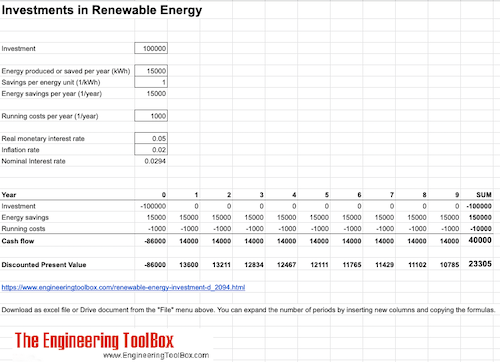Investments in Renewable Energy
Calculate investments in renewable energy.
Renewable energy - like the sun or wind - are available for free, but the equipment required to use the energy is not.
The economy in a renewable energy project can be calculated with alternative methods - the most common are
- payback time
- simple annual method
- discounted cash flow
Payback Time
Payback time - the time it takes to save or earn an amount equal to the investment - can be calculated as
t = I / A
= I / (E c) (1)
where
t = payback time (years)
I = investment
A = annual net income - or savings - from the investment
E = energy produced or saved per year (kWh/year)
c = cost or savings per energy unit (1/kWh)
Example - An Investment in a Windmill Generator
An amount of 100000 is invested in a windmill generator. The windmill is assumed to produce 8000 kWh/year . The cost to buy this energy from the local grid is 1 per kWh .
The savings on produced energy can be calculated as
A = (8000 kWh/year) (1 1/kWh)
= 8000
The payback time can be calculated to
t = 100000 / 8000
= 12.5 year
Renewable Energy - Payback Time Calculator
Simple Annual Method
The economy alternatively be evaluated by calculating the cost of the energy produced or saved. The cost of energy can be calculated as
c = (I / y + C) / E (2)
where
c = cost or savings per energy unit (1/kWh)
I = investment
y = investment lifetime (years)
C = average annual running costs (1/year)
E = energy produced or saved per year (kWh/year)
Example - An Investment in Solar Panels
An amount of 50000 is invested in a solar panel system with estimated annual energy production of 4000 kWh/year. The lifespan for the system is estimated to 25 year . The average annual cost to operate the system is assumed to be 1200 per year .
The cost of the produced energy can be calculated as
c = ((50000) / (25 years) + (1200 1/year)) / (4000 kWh/year)
= 0.8 1/kWh
Renewable Energy - Simple Annual Method Calculator
Discounted Cash Flow
Since money earned or spend in the future is not worth the same as money earned or spend today - it is common to discount the future cash flow back to a present value. The present value of the cash flows in a renewable project can be calculated as
P = F0 / (1 + i)0 + F1 / (1 + i)1 + F2 / (1 + i)2 + .... + Fn / (1 + i)n (3)
where
P = present value
F = cash flow
i = real interest rate
A renewable energy project typically start with a huge investment in the beginning continuing with smaller income and running costs. The cash flow for a typical year can be expressed as
Fn = En cn - Cn (3a)
where
Fn = cash flow per year (1/year)
En = energy produced or saved per year (kWh/year)
cn = costs or savings per energy unit (1/kWh)
Cn = running costs (1/year)
The real interest can be calculated as
in = (1 + imn) / (1 + iin ) - 1 (3b)
where
in = nominal interest rate
imn = real monetary interest rate
iin = rate of inflation
Example - Investment in Renewable Energy and Discounted Cash Flow
An investment of 100000 saves 15000 kWh/year in energy. The energy cost is 1 per kWh , running costs to operate the system is 1000 , inflation rate is 0.02 (2%) and the monetary interest rate is 0.05 (5%) .
A discounted present value for the project over 10 years can be calculated to 23305 as indicated in the Google spreadsheet below.
You can download a copy of the spreadsheet as an excel file to your computer or to your Google Drive. You are free to modify and use the copy as you want.




